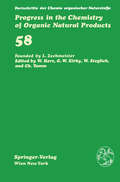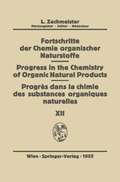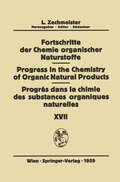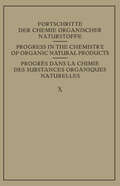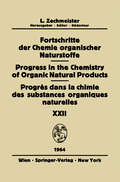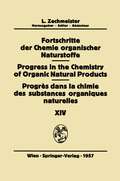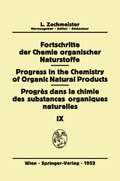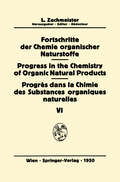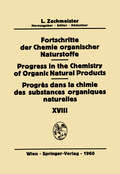- Table View
- List View
Fortschritte der Chemie organischer Naturstoffe / Progress in the Chemistry of Organic Natural Products (Fortschritte der Chemie organischer Naturstoffe Progress in the Chemistry of Organic Natural Products #89)
by Bernhard Kräutler N. P. SahuThe volumes of this classic series have appeared under the Springer Imprint ever since the series' inauguration in 1938. The volumes contain contributions on various topics related to the origin, distribution, chemistry, synthesis, biochemistry, function or use of various classes of naturally occurring substances ranging from small molecules to biopolymers. Each contribution is written by a recognized authority to provide an up-to-date review of the topic in question.
Fortschritte der Chemie organischer Naturstoffe / Progress in the Chemistry of Organic Natural Products (Fortschritte der Chemie organischer Naturstoffe Progress in the Chemistry of Organic Natural Products #55)
by M.T. Davies-Coleman J. Galambos L. Hough C. E. James R. Khan K. Krohn M. Lounasmaa D.E.A. RivettFortschritte der Chemie organischer Naturstoffe / Progress in the Chemistry of Organic Natural Products (Fortschritte der Chemie organischer Naturstoffe Progress in the Chemistry of Organic Natural Products #54)
by T. Murakami N. TanakaThe volumes of this classic series have appeared under the Springer imprint ever since L. Zechmeister founded the series in 1938. The volumes contain contributions on various topics related to the origin, distribution, chemistry, synthesis, biochemistry, function or use of various classes of naturally occurring substances ranging from small molecules to biopolymers. Each contribution is written by a recognized authority in his field and provides a comprehensive and up-to-date review of the topic in question. Addressed to biologists, technologists and chemists alike, the series can be used by the expert as a source of information and literature citations and by the non-expert as a means of orientation in a rapidly developing discipline.
Fortschritte der Chemie organischer Naturstoffe / Progress in the Chemistry of Organic Natural Products (Fortschritte der Chemie organischer Naturstoffe Progress in the Chemistry of Organic Natural Products #58)
by R.D.H. Murray J. A. Robinson0 e The volumes of this classic series, now referred to simply as "Zechmeister" after its founder, L. Zechmeister, have appeared under the Springer Imprint ever since the series' inauguration in 1938. The volumes contain contributions related to the origin, distribution, chemistry, synthesis, biochemistry, function or use of various classes of naturally occurring substances ranging from small molecules to biopolymers. Each contribution is written by a recognized authority in his field and provides a comprehensive and up-to-date review of the topic in question. Addressed to biologists, technologists, and chemists alike, the series can be used by the expert as a source of information and literature citations and by the non-expert as a means of orientation in a rapidly developing discipline.
Fortschritte der Chemie organischer Naturstoffe / Progress in the Chemistry of Organic Natural Products (Fortschritte der Chemie organischer Naturstoffe Progress in the Chemistry of Organic Natural Products #66)
by R.G.S. Berlinck T. Hatano T. Okuda T. YoshidaFortschritte der Chemie Organischer Naturstoffe/Progress in the Chemistry of Organic Natural Products (Fortschritte der Chemie organischer Naturstoffe Progress in the Chemistry of Organic Natural Products #26)
by L. ZechmeisterFortschritte der Chemie Organischer Naturstoffe / Progress in the Chemistry of Organic Natural Products 29 (Fortschritte der Chemie organischer Naturstoffe Progress in the Chemistry of Organic Natural Products #29)
by E. Glotter D. Goldsmith D. Gross J. R. Hanson S. Huneck F. Johnson D. Lavie E. Premuzic W. RüdgerFortschritte der Chemie organischer Naturstoffe Progress in the Chemistry of Organic Natural Products 69 (Fortschritte der Chemie organischer Naturstoffe Progress in the Chemistry of Organic Natural Products #69)
by D. Deepak J. F. Grove E. Haslam A. Khare N. K. Khare S. SrivastavaThe volumes of this classic series, now referred to simply as "Zechmeister” after its founder, L. Zechmeister, have appeared under the Springer Imprint ever since the series’ inauguration in 1938. The volumes contain contributions on various topics related to the origin, distribution, chemistry, synthesis, biochemistry, function or use of various classes of naturally occurring substances ranging from small molecules to biopolymers. Each contribution is written by a recognized authority in his field and provides a comprehensive and up-to-date review of the topic in question. Addressed to biologists, technologists, and chemists alike, the series can be used by the expert as a source of information and literature citations and by the non-expert as a means of orientation in a rapidly developing discipline.
Fortschritte der Chemie organischer Naturstoffe / Progress in the Chemistry of Organic Natural Products 85 (Fortschritte der Chemie organischer Naturstoffe Progress in the Chemistry of Organic Natural Products #85)
by D. P. Chakraborty K. Krohn P. Messner S. Roy C. SchäfferThe volumes of this classic series, now referred to simply as "Zechmeister” after its founder, L. Zechmeister, have appeared under the Springer Imprint ever since the series’ inauguration in 1938. The volumes contain contributions on various topics related to the origin, distribution, chemistry, synthesis, biochemistry, function or use of various classes of naturally occurring substances ranging from small molecules to biopolymers. Each contribution is written by a recognized authority in his field and provides a comprehensive and up-to-date review of the topic in question. Addressed to biologists, technologists, and chemists alike, the series can be used by the expert as a source of information and literature citations and by the non-expert as a means of orientation in a rapidly developing discipline.
Fortschritte der Chemie organischer Naturstoffe / Progress in the Chemistry of Organic Natural Products 86 (Fortschritte der Chemie organischer Naturstoffe Progress in the Chemistry of Organic Natural Products #86)
by A. GossauerFortschritte der Chemie organischer Naturstoffe / Progress in the Chemistry of Organic Natural Products 88 (Fortschritte der Chemie organischer Naturstoffe Progress in the Chemistry of Organic Natural Products #88)
by G. W. Kirby W. Herz Heinz FalkThe volumes contain contributions on various topics related to the origin, distribution, chemistry, synthesis, biochemistry, function or use of various classes of naturally occurring substances ranging from small molecules to biopolymers. Each contribution is written by a recognized authority in his field and provides a comprehensive and up-to-date review of the topic in question.
Fortschritte der Chemie Organischer Naturstoffe/Progress in the Chemistry of Organic Natural Products/Progres dans la Chimie des Substances Organiques Naturelŀes (Fortschritte der Chemie organischer Naturstoffe Progress in the Chemistry of Organic Natural Products #12)
by G. W. Beadle A.J. Haagen-Smit T. G Halsall F. T. Haxo E.R.H. Jones R. Michel J. Roche K. Slotta A. R. Thompson E.O.P. Thompson R. Tschesche F. L. WarrenSubstances belonging to this group of organic compounds are wi,lely distributed in Nature, being found in plants, both higher and lower fungi and, upto the present time, in one animal source, sheep wool-fat. For a long time no real differentiation was possible between the tetra- and penta cyclic triterpenes and the sterols. Then the two latter became disting uishable by their selenium. ·dehydrogenation products, i. e. , picene and naphthalene derivatives from the pentacyclic triterpenes and DIELS' hydrocarbon from the sterols. It is now apparent that those compounds yielding predominantly I: 2: 8-trimethylphenanthrene on dehydro genation represent yet another class, and this property is regarded as typical of the tetracyclic triterpenes. The group contains both C and C 30 3l compounds and, although the latter fall outside RUZICKA'S strict definition of triterpenes (I42), it seems desirable to permit this deviation. Members with thirty-two carbon atoms may well be discovered in due course. In a most· valuable account of the triterpenes written in I949, JEGER. (II3) was able to summarize all that was known about the tetra cyclic group in a very small compass. Most of the work discussed in the present article has been published during the last five years and in that time the structures of some twenty compounds have been elucidated. Of outstanding importance is the revelation of close structural relation ships tQ the steroids, and the presence of C and C side-chains, skeletally 8 9 identical with those of cholesterol and ergosterol.
Fortschritte der Chemie Organischer Naturstoffe / Progress in the Chemistry of Organic Natural Products / Progrès dans la Chimie des Substances Organiques Naturelles (Fortschritte der Chemie organischer Naturstoffe Progress in the Chemistry of Organic Natural Products #17)
by P. H. Abelson H. Barkemeyer K. Bernauer A. E. Dimond H. H. Inhoffen K. Irmscher F. Korte I. Korte H. Kuhn W. A. Schroeder B. B. Stowe K. VenkataramanFortschritte der Chemie Organischer Naturstoffe / Progress in the Chemistry of Organic Natural Products / Progrès dans la Chimie des Substances Organiques Naturelles (Fortschritte der Chemie organischer Naturstoffe Progress in the Chemistry of Organic Natural Products #11)
by A. Albert K. Brückner R. B. Corey K. Freudenberg H. H. Inhoffen R. Lemberg L. Pauling S Peat H. Schmid W. A. SchroederThe properties of proteins are determined not only by the sequence of amino-acid residues in the polypeptide chains, but also by the con figuration of the chains-the way in which the chains are coiled or folded. It is probable that denaturation, the loss of some of the specific properties of a native protein, may in many cases be the result simply of a change in configuration of the polypeptide chains, without any change whatever in the sequence of amino-acid residues. During the past few years great progress has been made in the attack on the determination of the sequence of amino-acid residues in the poly peptide chains of proteins, through the work of SANGER and his collabora tors (Io9, IIO) and of other investigators. There has also been significant progress in the attack on the problem of the configuration of polypeptide chains, largely through the application of the X-ray diffraction technique.
Fortschritte der Chemie Organischer Naturstoffe / Progress in the Chemistry of Organic Natural Products / Progres dans La Chimie des Substances Organiques Naturelles (Fortschritte der Chemie organischer Naturstoffe Progress in the Chemistry of Organic Natural Products #10)
by K. Alder J. Asselineau A. Chatterjee L. Feinstein M. Jacobson E. Lederer H. Mark G. Rosenkranz M. Schumacher F. SondheimerFortschritte der Chemie Organischer Naturstoffe / Progress in the Chemistry of Organic Natural Products / Progrès dans la Chimie des Substances Organiques Naturelles (Fortschritte der Chemie organischer Naturstoffe Progress in the Chemistry of Organic Natural Products #22)
by R. T. Aplin G. Billek J. F. Grove T. G. Halsall W. Keller-Schierlein V. Prelog K. Schaffner P. J. Scheuer H. ZähnerFortschritte der Chemie Organischer Naturstoffe / Progress in the Chemistry of Organic Natural Products / Progrès Dans la Chimie des Substances Organiques Naturelles (Fortschritte der Chemie organischer Naturstoffe Progress in the Chemistry of Organic Natural Products #8)
by Y. Asahina R. B. Corey A. Frey-Wyssling F. Galinovsky G. W. Kenner L. F. Leloir K. Mühlethaler M. Pailer C. R. Ricketts M. Rohdewald H. Schinz M. Stacey L. ZechmeisterIn agreement with SCHLENK (I78) "nucleotide" is here taken to mean a phosphoric ester of an N-glycoside of a heterocyclic base. Although they fall outside the scope of this definition, phosphorylated derivatives of riboflavin are added in recognition of their close relation to the main body of nucleotides. A complete review of even the organic chemistry of nucleotides and their derivatives would now form a substantial monograph. The smaller and less characteristic fragments of the nucleotides, namely the hetero cyclic bases, the component sugars and the derived sugar phosphates, are therefore excluded from this article. * Their chemistry is of longer standing and is covered in standard works. On the other hand knowledge of the "nucleosides", the N-glycosides of heterocyclic bases, has expanded very considerably in recent years and an account of the relevant work is therefore included. With regard to the nucleotides themselves attention is focussed on work published in the last few years leading to improved characterisation, more exact structural knowledge and increased availa biIity. Only such enzymatic experiments as bear direct1y on structural problems are discussed and therefore much fascinating work by KALCKAR, FRIEDKIN et al. and by KORN BERG has been omitted. I t would be unthinkable to present a review on nucleotides without mentioning that the foundations of the subject were laid by P. A. LEVENE. His monograph with BASS (I36) was published in 1931 and two reviews by LYTHGOE (I50, I5I) cover the intervening period until 1944.
Fortschritte der Chemie Organischer Naturstoffe/Progress in the Chemistry of Organic Natural Products/Progrès Dans la Chimie des Substances Organiques Naturelles (Fortschritte der Chemie organischer Naturstoffe Progress in the Chemistry of Organic Natural Products #14)
by N. Barsel A. J. Birch F. Bohlmann H. Brockmann H. Brown J. D. Chanley H. J. Mannhardt R. A. Morton G.A.J. Pitt H. Sobotka C. TammFortschritte der Chemie Organischer Naturstoffe/Progress in the Chemistry of Organic Natural Products/Progrès Dans La Chimie Des Substances Organiques Naturelles (Fortschritte der Chemie organischer Naturstoffe Progress in the Chemistry of Organic Natural Products #9)
by J. G. Baxter H. Borsook N. Bulman D. H. Campbell F. M. Dean H. H. Inhoffen H. M. Kalckar W. S. McNutt P. Meunier H. Siemer A. Stoll M. TomitaFortschritte der Chemie organischer Naturstoffe / Progress in the Chemistry of Organic Natural Products / Progrès Dans La Chimie Des Substances Organiques Naturelles (Fortschritte der Chemie organischer Naturstoffe Progress in the Chemistry of Organic Natural Products #5)
by G. W. Beadle F. E. Brauns V. Deulofeu M. Doudoroff D. L. Fox E. Geiger A.J. Haagen-Smit W. Z. Hassid T. P. Hilditch P. Karrer E. Pacsu R. S. RasmussenFortschritte der Chemie organischer Naturstoffe/Progress in the Chemistry of Organic Natural Products/Progrès dans la Chimie des Substances Organiques Naturelles (Fortschritte der Chemie organischer Naturstoffe Progress in the Chemistry of Organic Natural Products #7)
by B. Becker A. H. Cook H. Heusser O. Jeger C. Niemann A. Stoll J. W. WilliamsFortschritte Der Chemie Organischer Naturstoffe / Progress in the Chemistry of Organic Natural Products / Progrès Dans La Chimie Des Substances Organiques Naturelles (Fortschritte der Chemie organischer Naturstoffe Progress in the Chemistry of Organic Natural Products #24)
by K. Biemann H. Erdtman H. Fraenkel-Conrat O. Hoffmann-Ostenhof H. Kindl T. Norin R. Tschesche A. B. Turner F. L. WarrenDuring the past three decades the organic chemist has become in creasingly used to take advantage of more and more complex instrumenta tion and physical measurements in lieu of laborious, time-consuming and often ambiguous chemical transformations. Mass spectrometry is perhaps the most recent, most complex and most expensive addition to this field. In view of the astonishingly quick acceptance of nuclear magnetic reso nance by the organic chemist it is, in retrospect, surprising that he has neglected mass spectrometry for such a long time. This can be explained, in part, by the complexity of the instrumentation and some technical shortcomings of the earlier commercially available instruments but, to an even greater extent, it reflects also the prejudices against a technique that was originally mainly used for quantitative gas analysis. The usefulness of mass spectrometry as a qualitative technique in organic chemistry rather than a tool for quantitative analysis was more and more recognized towards the end of the last decade. A rather spectacular development followed during the intervening few years to the point that now any reasonably well equipped modern organic laboratory is supplied with, or at least has access to, one or more mass spectrometers suitable for work on organic compounds. Within the realm of organic chemistry the technique has become much more important, if not indispensable, for the natural products chemist while its application to synthetic problems is much less pro nounced.



